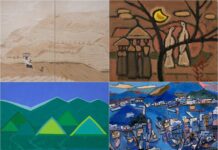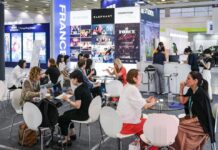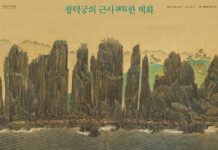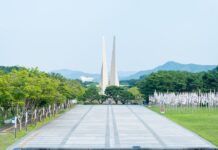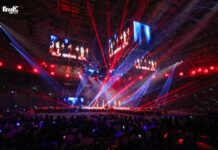
The City in Art, Art in the City exhibit opens at the National Museum of Korea on Oct. 5, with a focus on works of art that depict life in cities from the 1700s through to the early 1930s.
Crowds of people, no taller than half a fingernail, walk left and right along a riverbank, going about their daily business. In another corner of town, a group gathers around two men about to start what looks like a wrestling match. Others are busy selling goods in the market, or sightseeing, playing games or bickering with neighbors. You can even make out distinct facial features of the peddlers, the fishermen rowing their boats and of the masses crossing over the bustling bridge.
These are scenes from “Along the River During the Qingming Festival” (淸明上河圖) by Chinese artist Qiu Ying (仇英) (1494-1552). The painting is one of many currently being shown at the City in Art, Art in the City exhibit that opened at the National Museum of Korea on Oct. 5.
Showcasing some 370 artworks that spotlight life in cities from the 18th century through to the 1930s, the exhibit gives visitors a chance to compare the ancient cities of Korea, China and Japan. The cities depicted in the massive wall-sized paintings provide snapshots of urban landscapes and their inhabitants, while also showing the aesthetic values and sensibilities of artists from those times.

A subsection of ‘Along the River During the Qingming Festival’ (淸明上河圖) by Qing artist Qiu Ying (仇英) is a Chinese national treasure kept at the Lioaning Museum.

‘Prosperous Suzhou’ by Qing court painter Xu Yang (徐揚) depicts the city of Suzhou, in Jiangsu Province, at the height of its prosperity in the 18th century. More than 4,800 people are illustrated in this 12-meter painting.
On display at the exhibit are two national treasures from China on loan from the Liaoning Museum: “Along the River During the Qingming Festival” by Qiu Ying (仇英), and “Prosperous Suzhou” (姑蘇繁華圖) by Xu Yang (徐揚, 1712-1779). These two works of art, rarely exhibited together, can be enjoyed by the public only until Oct. 23. The two paintings are classic works from the Ming Dynasty and feature the plentiful and energetic landscapes of early modern Chinese cities. The pieces were created in Suzhou (蘇州), in the southeastern province of Jiangsu in eastern China, that served as an economic, cultural and commercial hub during the Ming and Qing dynasties. The scenes depicted in the paintings show a vibrant city filled with bustling crowds. “Prosperous Suzhou,” painted by court painter Xu Yang during the Qing Dynasty, has more than 4,800 people filling the streets of the dynamic city.

The ideal city imagined by artists of late Joseon is depicted in ‘The City of Supreme Peace’ (太平城市圖) that shows the bustling city of Hanyang, today’s Seoul, the center of politics and commercial business during the late 18th century.
The exhibit also provides an opportunity to compare the two Chinese paintings to Korean and Japanese landscapes.
“The City of Supreme Peace” (太平城市圖) is a folding screen painting that depicts Hanyang, today’s Seoul and Joseon’s center of politics and business, during the late 18th century. In the hustle and bustle of the busy streets, miniature inhabitants can be spotted in the midst of everyday activities, like cutting tobacco leaves, weaving cloth on the loom, or placing giwa tiles on the roofs of the buildings.
Visitors can also take a look at the “Complete View of Hwaseong Fortress” (華城全圖), a painting that served as a blueprint for the new city that King Jeongjo (正祖, 1752-1800), the 22nd Joseon monarch, wished to build in Suwon, Gyeonggi-do Province.
These paintings can then be compared to “Scenes in and Around Kyoto” (洛中洛外圖) that presents an idealized version of Kyoto, Japan. Surveying the exhibition hall, visitors will enjoy looking for similarities and differences between the three countries’ urban utopias.

Visitors take a close look at ‘Along the River During the Qingming Festival’ (淸明上河圖) (left) and ‘Prosperous Suzhou,’ two national treasures from China currently on display at the National Museum of Korea in Seoul.
There is also a chance to take a closer look at the pleasantries enjoyed by ordinary people during Joseon times, depicted in paintings by Joseon’s celebrated folk artists.
The “Album of Genre Paintings” (단원풍속도첩, 檀園風俗圖帖) by Kim Hong-do presents the lives of common people, showing their work, their play, and even their love, in a collection of 25 paintings. A collection of 30 works by Shin Yun Bok from the Hyewonjeonshincheop collection (혜원전신첩, 蕙園傳神帖) spotlights the pleasantries of love and entertainment enjoyed by ordinary folk, giving audiences a closer look at life in 18th century Joseon.

In addition to paintings depicting ancient cities, the City in Art, Art in the City exhibit showcases portraits, furniture, pottery and other ornaments from 18th century Joseon.
The City in Art, Art in the City exhibit runs until Nov. 23. During the exhibition, there will be guided tours at four times every day in Korean. On Wednesdays at 7 p.m., you can attend a talk with a curator and listen to a presentation about the stories behind the artworks, also in Korean.
More information about the exhibit can be found at the museum’s website.
https://www.museum.go.kr/site/main/home
By Lee Hana
Korea.net Staff Writer
Photos: Jeon Han, Korea.net Staff Photographer, National Museum of Korea
hlee10@korea.kr


